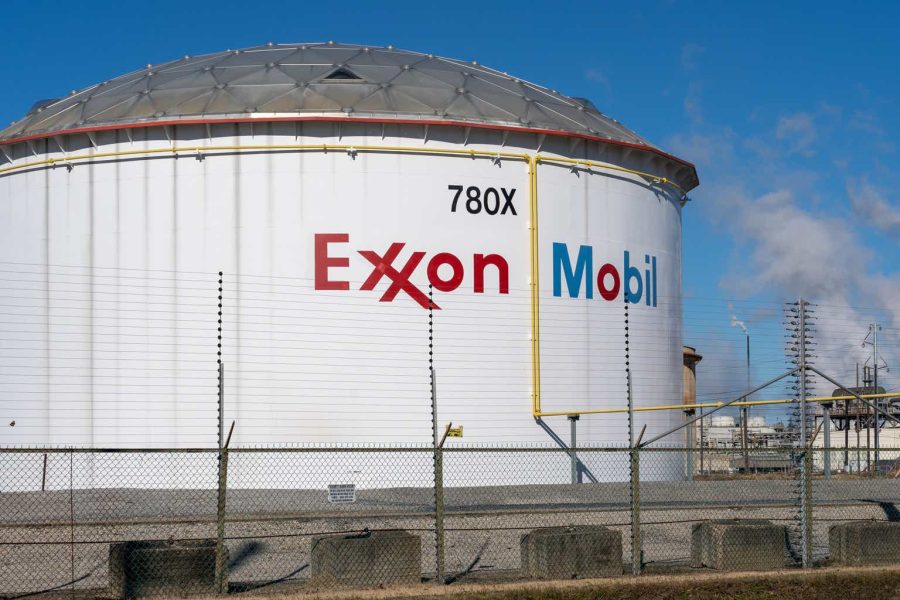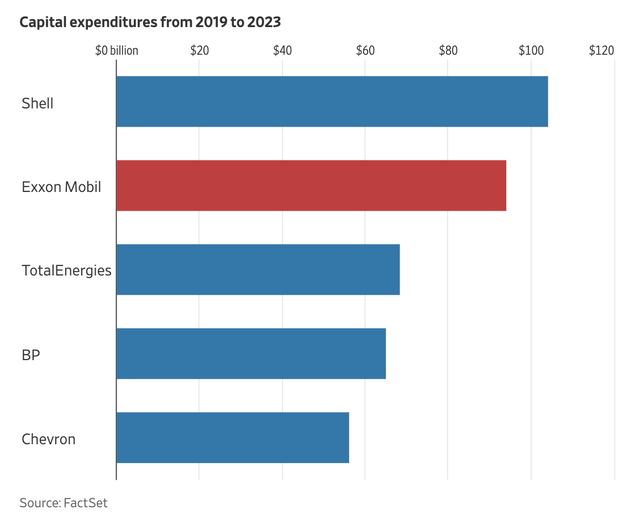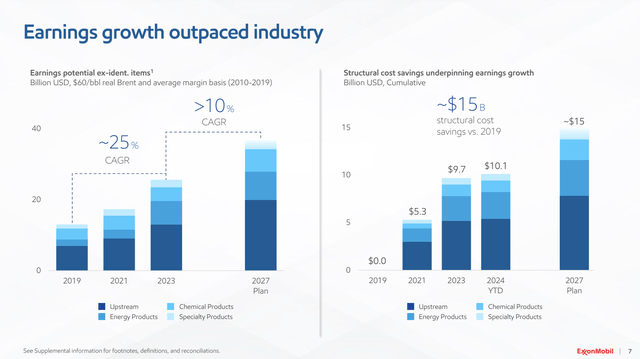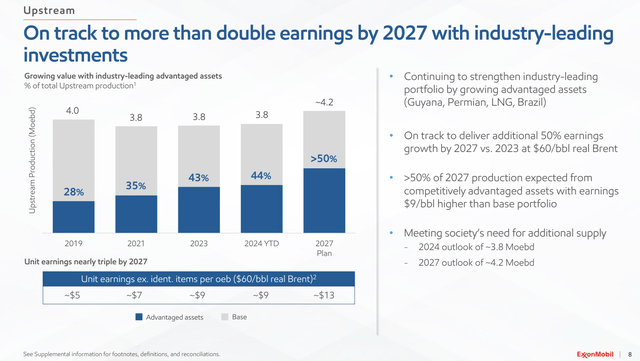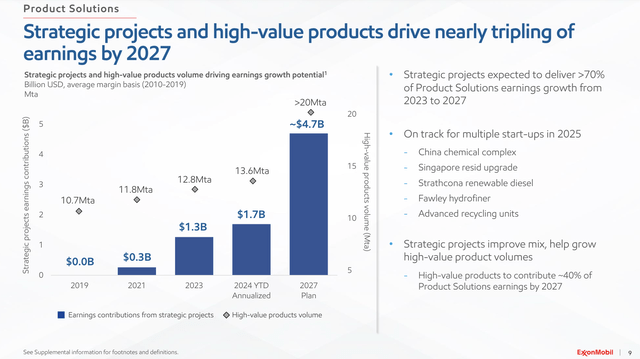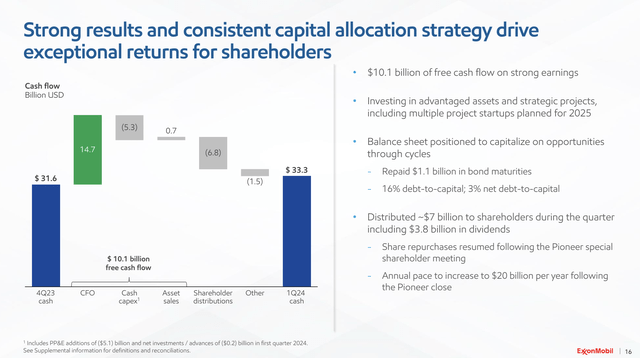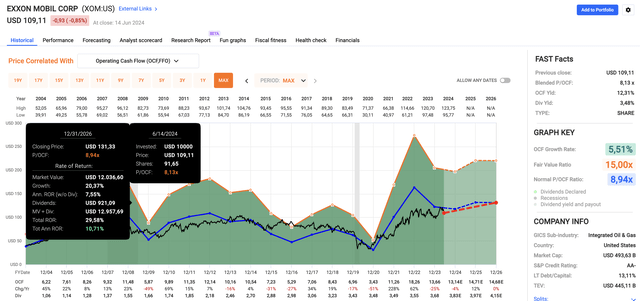Summary:
- U.S. companies, particularly in tech and energy, outperform global counterparts.
- Exxon Mobil’s focus on core operations, strategic investments, and shareholder value make it a reliable investment.
- Strong financial health, massive shareholder distributions, and solid credit rating make Exxon Mobil a dependable choice for income-focused investors.
JHVEPhoto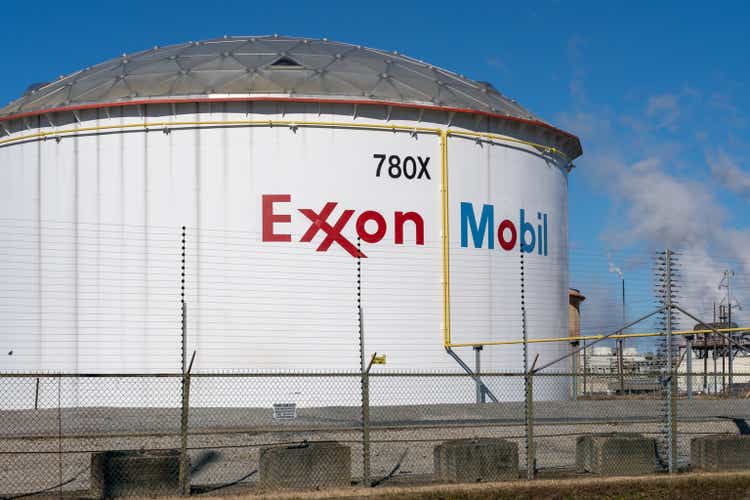
Introduction
The U.S. is the place to be.
Personally, I have invested 100% of my money in companies in the United States, which is based on factors like better energy security, political stability (despite all the turmoil), and the wide range of fantastic securities to pick from.
Over the past ten years, the S&P 500 has returned 235%. The iShares MSCI All-World ex U.S. ETF (ACWX) returned just 44%!
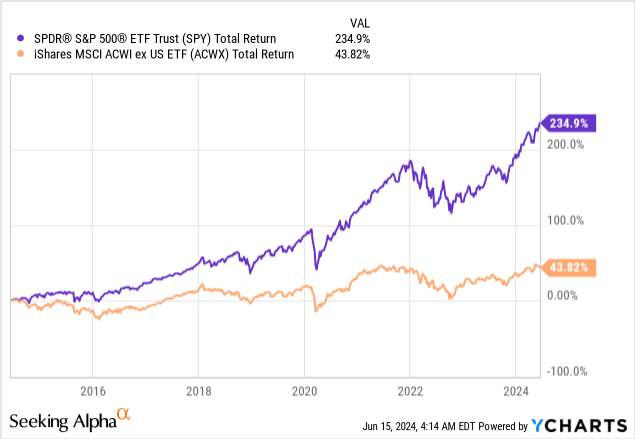
While this trend will reverse at some point in the future, the market is still eager to bet on the U.S., as the S&P 500 just had its best week relative to the ACWX since March 2023!
Bloomberg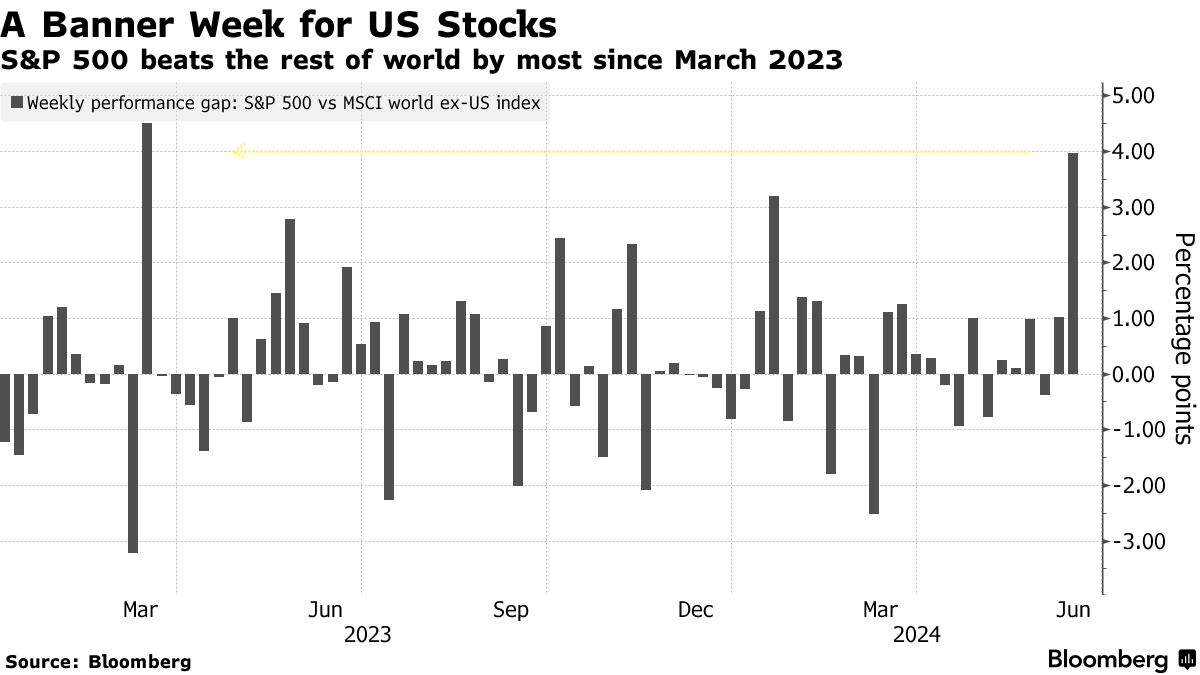
In an uncertain global economic environment, investors are flocking to artificial intelligence and big tech, in general, which is dominated by American gems like NVIDIA (NVDA), Apple (AAPL), Alphabet (GOOGL), and others.
What’s interesting is that America’s dominance goes beyond tech.
It also has the most successful oil majors.
Although the French energy giant TotalEnergies (TTE) has caught up, both Chevron (CVX) and Exxon Mobil (NYSE:XOM) have been much better investments than their European peers over the past ten years.
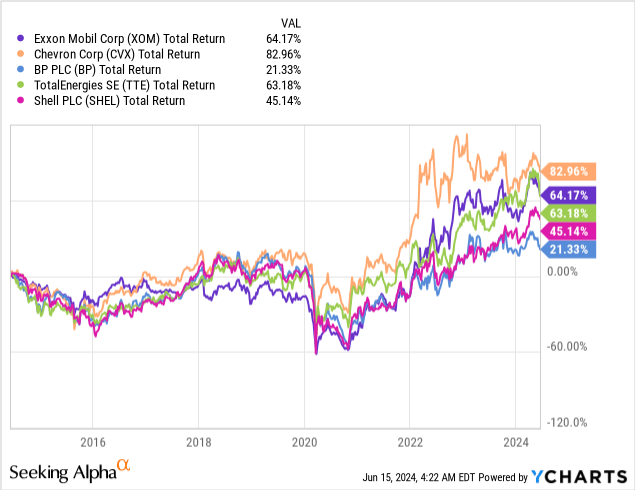
One problem of European companies was their focus on renewable energy. In order to please Western governments and activists, they increasingly focused on wind and solar power, investing billions in charging networks and other solutions.
While I have nothing against those technologies, they should have focused on what they do best: producing oil and gas.
I believe European majors simply neglected the importance fossil fuels will play even decades from now and gave in to social pressures to appear “green.”
American companies didn’t do that – at least to a much lesser extent.
That’s why I bought Exxon Mobil in 2020, shortly after the news broke that Zoom Video Communications (ZM) had risen above its market cap during the crazy pandemic.
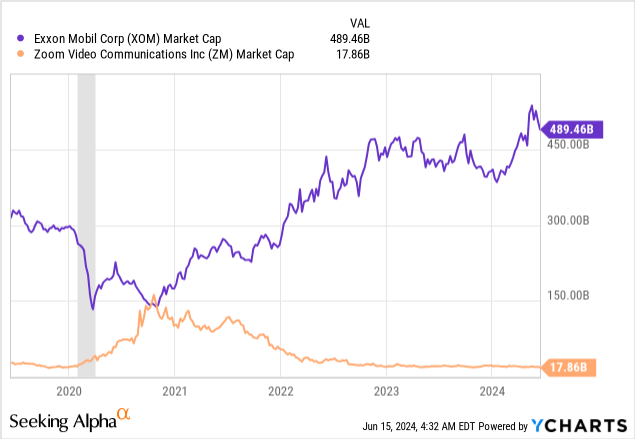
While I have sold it since then to focus on oil companies that pay special dividends, Exxon remains a beacon of stability, supported by a double-A credit rating.
In my most recent article, written on March 11, I covered my decision to focus on smaller oil companies with special dividends and potentially more upside potential.
Since then, shares are up roughly 2%.
In this article, I’ll focus on what makes Exxon special as an oil major, which includes much more than just a “focus on oil,” as the company has become serious about growing output, potentially benefitting from both higher production and pricing for many years to come.
As that would be great news for shareholders for a number of reasons, let’s dive into the details!
Exxon Is Serious About Shareholder Value
The Telegraph said it best when it perfectly summarized Exxon Mobil’s success in recent years in an article last month (emphasis added):
By any measure, ExxonMobil has experienced extraordinary financial success in recent years. Under its current management and Board, the company has recorded record profits over the past two years. Its stock price hit an all-time high in April, and the company’s market capitalisation is also at a record high following the closing of its $60 billion takeover of Permian Basin giant Pioneer Natural Resources. – The Telegraph
The article was about a legal fight with major investors like public pension fund managers from California, New York, and Illinois (among others) who want to force Exxon to reduce its greenhouse emissions to achieve net zero by 2050.
While Exxon is working on measures to improve operations and reduce the environmental impact of its operations (as it should – I think), it remains focused on the core of its business, which is perfectly captured by the quote below:
Although they’ve invested billions in ESG-friendly projects to lower emissions in recent years, Exxon’s board and management team led by Woods have remained focused on maximizing investor returns by prioritising the company’s highly-profitable core oil and gas enterprise. – The Telegraph
Prioritizing highly profitable core oil and gas operations is what the company has been doing in recent years by spending massive amounts of capital.
As we can see below, since 2019, the company has invested roughly $94 billion in CapEx. That’s 67% more than its peer, Chevron.
Among the majors, only Shell (SHEL) has spent more capital.
Spending focused on two critical areas, both with massive success:
In Guyana, where a lot of that spending was directed, all of its three projects are producing above their initial design plans and achieved record gross production in the first quarter.
In the Permian Basin, another area Exxon plowed money into, it has more than doubled production volume since 2019. Exxon’s execution has arguably looked better than that of Chevron, which had run into delays and cost overruns on its joint-venture expansion project in Kazakhstan. Chevron also missed its production growth target last year. – The Wall Street Journal (emphasis added)
Also, for what it’s worth, The Wall Street Journal comment above showed Exxon is outperforming its peer Chevron in the mighty Permian.
Moreover, during its 1Q24 earnings call, the company noted that growth initiatives and technological innovations are expected to provide strong long-term growth, with expectations to generate an additional $12 billion in earnings from 2023 to 2027. This represents a compound annual growth rate of more than 10%.
Most of these tailwinds are expected to come from upstream (oil and gas production), with guidance of roughly $15 billion in cost savings by 2027.
Adding to that, ExxonMobil’s move into low-carbon solutions, like carbon capture and storage, hydrogen, and advanced recycling projects, positions the company at the forefront of the energy transition – without having to go into high-risk renewable projects.
For example, during its 1Q24 call, the company noted the Baytown low-carbon hydrogen project and the potential for developing 1 billion pounds per year of plastic waste processing capacity by 2027.
Speaking of 2027, the company aims to produce 1.3 million barrels of oil per day in Guyana by then, which would be truly impressive just eight years after “first oil.”
The aforementioned Permian, Guyana, and other projects are expected to double the company’s upstream earnings potential by 2027, with more than half of 2027 production coming from “advantaged assets” with earnings that are $9 per barrel higher than the base portfolio!
While I have often criticized Exxon for being “too boring,” this is a major step in the right direction, as it bodes well for both output and margins.
The same is visible in its Product Solutions, where strategic projects are expected to boost output by almost 100% through 2027, increasing earnings potential to $4.7 billion (tripling potential from 2019 to 2027), with high-value projects accounting for roughly 40% of segment earnings.
So, what does this mean for shareholders?
Exxon Shareholders Remain In A Good Place
As I have said in prior articles, I prefer smaller oil companies with a focus on special dividends. Often, these come with higher risks, as XOM has fantastic diversification.
In general, I believe buying XOM is like owning an energy/chemicals ETF.
- Investors get high-quality upstream exposure.
- They get a massive refinery portfolio.
- Given Exxon’s focus on chemicals, investors own that sector as well.
On top of that, it’s a great source of steadily rising income with support from buybacks.
While it may not come with special dividends, it comes with reliability, which a lot of investors I talk to on Seeking Alpha value more than anything else.
In the first quarter alone, XOM distributed $7 billion to shareholders. That’s 1.4% of its $490 billion market cap and consisted of $3.8 billion worth of dividends and roughly $3.2 billion of buybacks.
As we can see below, despite these distributions, the company boosted its total cash to $33.3 billion, 7% of its market cap. Note that it has a 3% net debt-to-capital ratio and a double-A credit rating, making it one of the safest energy companies on the planet.
On a full-year basis, the company aims to increase its share repurchase program to $20 billion after it closes the Pioneer deal.
$20 billion is 4.1% of its market cap, which is a very attractive bonus on top of its 3.5% dividend yield. This implies a total annualized payout of 7.6%.
With regard to its dividend, the most recent hike was 4.4% on October 27. The five-year CAGR is 2.5%, which includes the pandemic, when the company decided to keep its dividend unchanged.
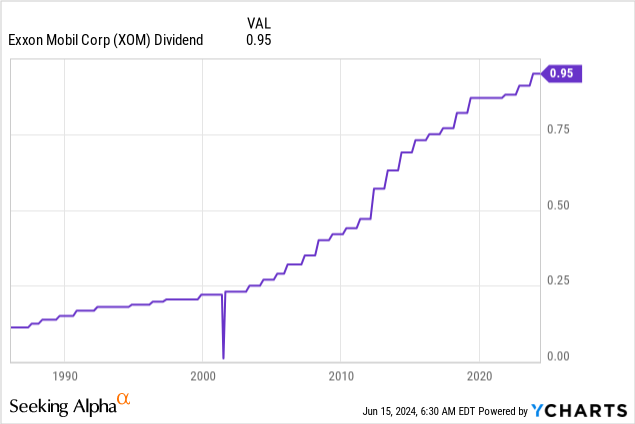
While dividend growth may be underwhelming, I expect that future dividend growth will be higher, especially once it unleashes aggressive buybacks and has a clear game plan for 2027.
It also needs to be said that analysts are extremely upbeat about its free cash flow growth potential.
Under current circumstances, analysts expect the company to boost free cash flow to $42 billion next year, 9% of its market cap. This indicates a well-protected dividend, room for future dividend growth, potential for buybacks, and liquidity for future growth projects.
It also enjoys an attractive valuation.
Valuation
Exxon currently trades at a blended P/OCF (operating cash flow) ratio of 8.1x, slightly below its normalized P/OCF ratio of 8.9x.
While I believe the company deserves an OCF ratio of at least 9.5x in the years ahead to account for more favorable oil supply/demand developments, strategic investments in low-cost operations, and rapid growth in chemicals, even an 8.9x multiple implies a fair stock price of $131.
This is based on FactSet OCF estimates from the chart below ($14.70 in per-share OCF in 2026).
The current consensus price target is $132.
All things considered, I don’t have Exxon on my watch list, as I prefer special dividends and pure-play upstream companies.
However, as I already briefly mentioned, I am bullish on the company and consider it to be a great stock for income-focused investors who prefer reliable, consistent growth backed by a well-diversified business model.
Trading roughly 20% below what I consider its fair price target, I expect Exxon to deliver elevated long-term returns, boosted by potentially accelerating dividend growth, significant buybacks, and an overall favorable operating environment for oil companies.
Takeaway
Despite global uncertainties, U.S. companies, especially in tech and energy, continue to outperform.
Exxon Mobil’s focus on its core oil and gas operations, significant investments in the Permian Basin and Guyana, and strategic low-carbon initiatives position it for sustained growth.
Meanwhile, its fantastic financial health and focus on shareholders, reflected in massive shareholder distributions and a solid credit rating, make it a reliable choice for income-focused investors.
While I lean towards smaller pure-play oil companies with special dividends, Exxon Mobil stands out as a reliable, diversified investment poised for potentially elevated long-term returns.
Pros & Cons
Pros:
- Reliable Income: Exxon Mobil offers a steadily rising dividend, supported by significant buybacks and a healthy balance sheet.
- Strong Operations: The company has outperformed peers, mainly in the Permian Basin and Guyana, with promising growth opportunities in the years ahead.
- Diversification: Owning XOM is like holding an energy/chemicals ETF, which comes with exposure to upstream, refining, and chemicals sectors.
- Financial Stability: With a double-A credit rating, low debt, and substantial cash reserves, Exxon is one of the safest energy investments.
Cons:
- Dividend Growth: Although the company’s dividend is reliable, Exxon’s dividend growth has been modest in recent years.
- Lack of Special Dividends: Unlike smaller oil companies, XOM does not offer the high-yield special dividends I prefer.
- Cyclical demand: While I believe oil and gas are in a much more favorable operating environment after U.S. shale output growth has peaked, it is still a highly cyclical industry prone to stock price weakness when recession risks rise.
- Environmental Pressures: Ongoing legal and social pressures to reduce emissions could impact future operations and profitability. However, so far, XOM management has shown its capability to withstand these pressures and balance investments in low-emission projects with high-margin legacy operations.
Analyst’s Disclosure: I/we have no stock, option or similar derivative position in any of the companies mentioned, and no plans to initiate any such positions within the next 72 hours. I wrote this article myself, and it expresses my own opinions. I am not receiving compensation for it (other than from Seeking Alpha). I have no business relationship with any company whose stock is mentioned in this article.
Seeking Alpha’s Disclosure: Past performance is no guarantee of future results. No recommendation or advice is being given as to whether any investment is suitable for a particular investor. Any views or opinions expressed above may not reflect those of Seeking Alpha as a whole. Seeking Alpha is not a licensed securities dealer, broker or US investment adviser or investment bank. Our analysts are third party authors that include both professional investors and individual investors who may not be licensed or certified by any institute or regulatory body.
Test Drive iREIT© on Alpha For FREE (for 2 Weeks)
Join iREIT on Alpha today to get the most in-depth research that includes REITs, mREITs, Preferreds, BDCs, MLPs, ETFs, and other income alternatives. 438 testimonials and most are 5 stars. Nothing to lose with our FREE 2-week trial.
And this offer includes a 2-Week FREE TRIAL plus Brad Thomas’ FREE book.
